How To Make Perfect Coffee No Matter Which Coffee Maker You Choose
Make a fantastic cup every time with this comprehensive guide to using five different types of coffee maker
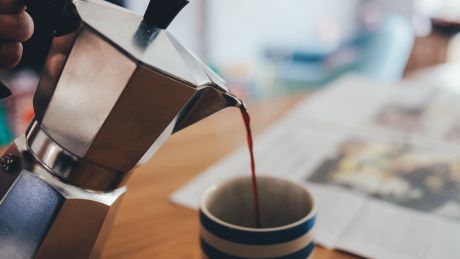
Legend has it that we have restless Ethiopian goats to thank for coffee. As the story goes, a goat herder called Kaldi spotted a link between his goats eating berries from a certain tree and being too energetic to sleep at night, so he investigated the berries himself. From there, word of coffee’s magical taste and energising qualities spread first to the Arabian peninsula and then eventually to Europe in the 17th century.
Coffee is now everywhere and the health benefits of drinking it evidently extend well beyond an extra jolt of energy. You can expect to enjoy those benefits whichever method you use to make your morning cup, but how you brew it does result in big changes to coffee’s flavour and strength.
We’ve explained the most popular methods of making coffee below, but before we get into specifics, let’s go over some basics with Simon Lewthwaite of specialist coffee company Caravan Coffee Roasters.
What are the different methods of making coffee?
There are three principles that underpin every method of making coffee – immersion, pressure or drip.
“Immersion is the soaking of coffee in hot or cold water for a period of time,” says Lewthwaite. “The intensity or flavour is altered by changing the dose [amount] of coffee used, the length of time you immerse it for and also the coarseness of the grind on the coffee. Once immersion is complete, you remove the coffee from the liquid and serve.”
“Pressure is when force is applied to the coffee. The highest being espresso at 9bar or so, and then down to AeroPress which varies based on how hard you press the coffee through the filter. An AeroPress actually combines both immersion for the brewing part and pressure for the press part.”
“Drip methods include your basic filter pot or American diner-style brewed coffee, Chemex, V60 and Kalita. This method uses gravity to pass the water through coffee grounds. The flavour is altered mostly by changing the dose of coffee and its grind consistency. A fine grind takes longer to filter through and is more intense in flavour, and a coarse grind takes a shorter time, with much less body produced.”
Get the Coach Newsletter
Sign up for workout ideas, training advice, reviews of the latest gear and more.
What is the best water temperature to brew coffee with?
If you’re boiling a kettle and splashing it straight into a cafetière, you’re doing coffee wrong.
“Generally around 92-94°C, but at times I brew with an AeroPress at home using 84-85°C water,” says Lewthwaite.
“The hotter the water, the faster and more intense the transfusion of flavour will be. Too hot can create a unpleasant cup; too cold, and the coffee will not react with the water and there will be less flavour or intensity in the resulting cup.”
Do different styles of making coffee require different grinds?
If you purchase your coffee from a specialist establishment like Caravan, you can often ask for the beans to be ground to the appropriate coarseness for your preferred method of coffee making.
“Generally, the shorter the drink, the finer the grind,” says Lewthwaite.
“You’re creating an intense flavour in a much shorter time. Whereas when you are making a large batch filter, the grind will be a lot coarser because it will be in contact with water for a much longer time.”
What are the pros and cons to different styles of coffee making?
“There are no cons when you make it well!” says Lewthwaite.
So to avoid doing it wrong, here are Lewthwaite’s six essential factors for brewing coffee, whatever your favourite method is.
- Quality coffee
- Clean water
- Freshly ground coffee
- Water-to-coffee ratio (you can’t go wrong with 60g/1,000ml)
- Appropriate brewing method for the coffee and grind
- Appropriate filtration method – the right thickness and style of filter
Got all that? Good, then let’s look into each of the five main methods of brewing coffee more closely.
Cafetière
The classic immersion method – no home is complete without a cafetière (also known as the French press) in the kitchen cupboard.
“You want a coarse grind of coffee, brew for four minutes with 90°C water (boil the kettle then let it sit for two minutes before pouring),” says Lewthwaite. “Use 60g of coffee per litre of water. After four minutes, decant the coffee into another vessel to stop the brewing process.”
The Best Cafetière: Bodum Chambord
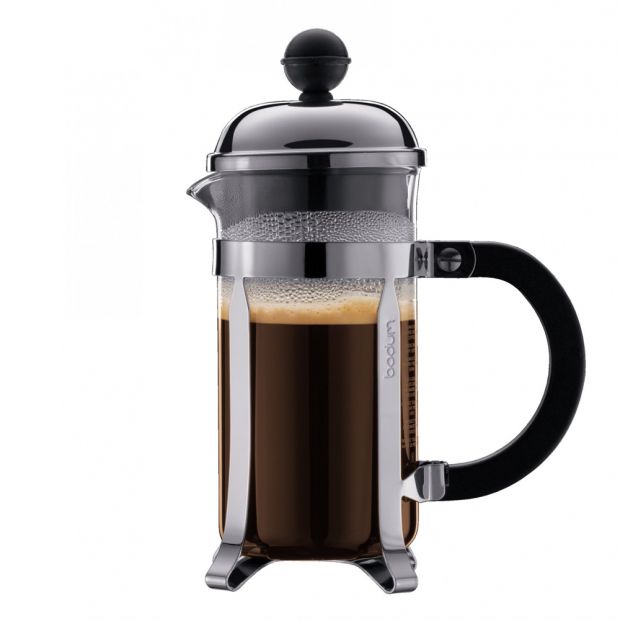
When it comes to the French press, you really can’t go wrong with Bodum. The classic Chambord cafetière is simple, stylish and fit for all your immersion coffee needs. RRP £39 (1 litre model), check price and buy on amazon.co.uk
Drip Filter Machine
An office staple, filter coffee gets a bad rap generally because people don’t take enough care when making it. Not to mention the fact many colleagues “forget” to refill the jug when they finish it.
“Use a coarse grind and the appropriate paper filter,” says Lewthwaite. “Check the volume of water the machine will hold and adjust your coffee dose to that, keeping to 60g per litre.”
The Best Drip Filter Machine: Ninja Coffee Bar
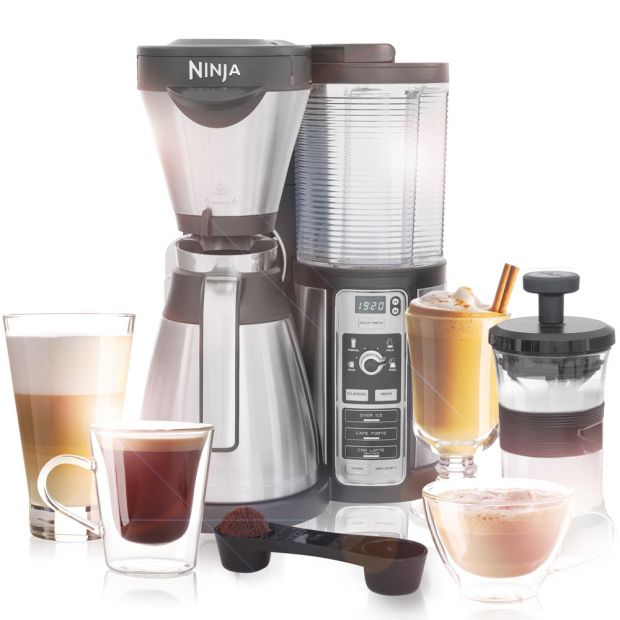
A raft of customisable features – including two strength settings, four size of brew options, and a timer that allows you to wake up to freshly brewed coffee – set this machine apart from the drip filter pack. RRP £180, check price and buy on amazon.co.uk
Espresso Machine
You can spend a lot of time perfecting your espresso with a proper machine. It’s one of the best ways to pass a lazy Sunday, in fact… Or you can use this cheat sheet.
“Use a 2:1 ratio of water to coffee. If your dose is 16g, then you can expect a good extraction at around 32g of coffee – note not 32ml,” says Lewthwaite. “You’re looking to balance three things: sweetness, bitterness and acidity.”
The Best Espresso Machine: De’Longhi Scultura
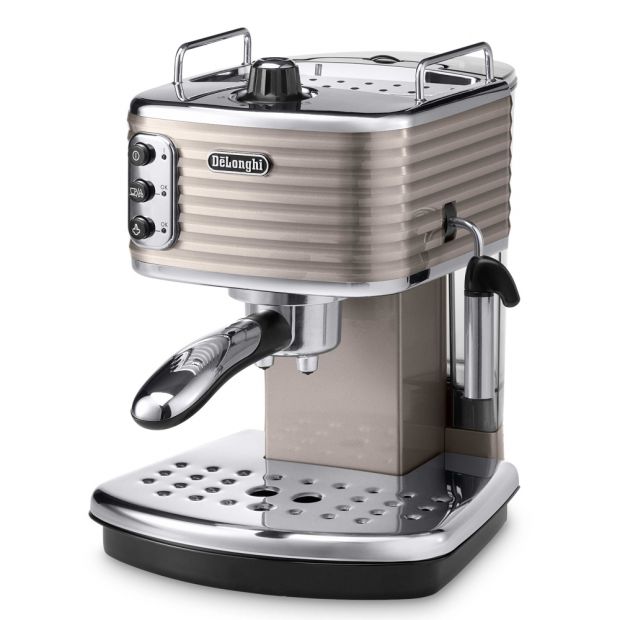
An easy-to-use and stylish machine that consistently produces impressive espresso shots, the Scultura is a great pick at an affordable price. RRP £200, check price and buy on amazon.co.uk
AeroPress
The (relatively) new kid on the block, the AeroPress is beloved by coffee obsessives worldwide for its ability to create smooth, strong coffee anywhere you take it.
Here’s Caravan Coffee Roasters’ precise step-by-step guide to using the AeroPress.
- Put a filter into the AeroPress screw cap, then attach it to the AeroPress and pour boiling water through it (this removes any slight paper taste).
- Add 16g of medium-grind coffee (consistency of table salt). If you really want to be exact, you can now place the whole set-up on a set of scales, then tare/zero them ready to put in the perfect amount of water.
- Pour in 250g of water (ideal temperature is 91-94°C), quickly stir the mixture and pop the AeroPress plunger into the tube – it needs to create a vacuum seal to stop water leaking through the filter.
- After 1min 15sec, start pressing the plunger down to push the coffee through into a mug. This should take 30sec, for a total brew time of 1min 45sec.
The One And Only AeroPress: Aerobie AeroPress
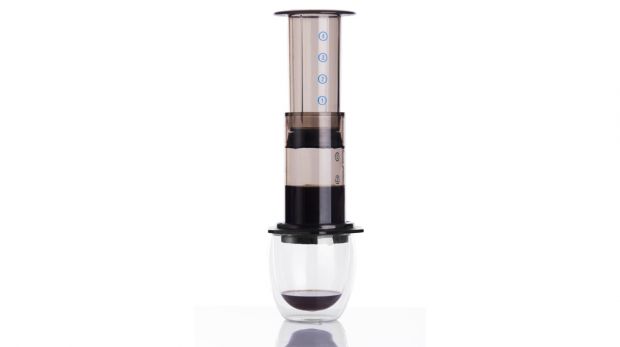
No options here, there’s only one AeroPress on the market, so instead a fun fact; Aerobie only makes two things – the AeroPress and frisbees. A masterclass in diversification, that. RRP £30, check price and buy on amazon.co.uk
Stove-Top Espresso
Another pressure method to make coffee, but with a stove-top espresso maker water is forced upwards through the coffee. Here’s Lewthwaite’s step-by-step guide to nailing stove-top coffee.
- “Fill the base to just below the valve with filtered water.”
- “Fill the coffee reservoir with a fine grind (close to espresso) and pack it in with the back of a spoon.”
- “Place on the stove top, but only on medium or just under medium heat. This will take longer, but it’ll stop the water boiling and burning the coffee inside.”
- “Keep a close eye on the brewing coffee. Once it starts extracting through into the top, do not let it spray and spit through. Instead reduce the temperature to allow it to flow nicely.”
- “As soon as the colour of the coffee becomes lighter, wrap a cold wet cloth around the base. This will stop the extraction and take away the risk of overbrewing. This bit is hard to master, but it’s super obvious when you nail it!”
The Best Stove-Top Espresso Maker: Bialetti Moka Express
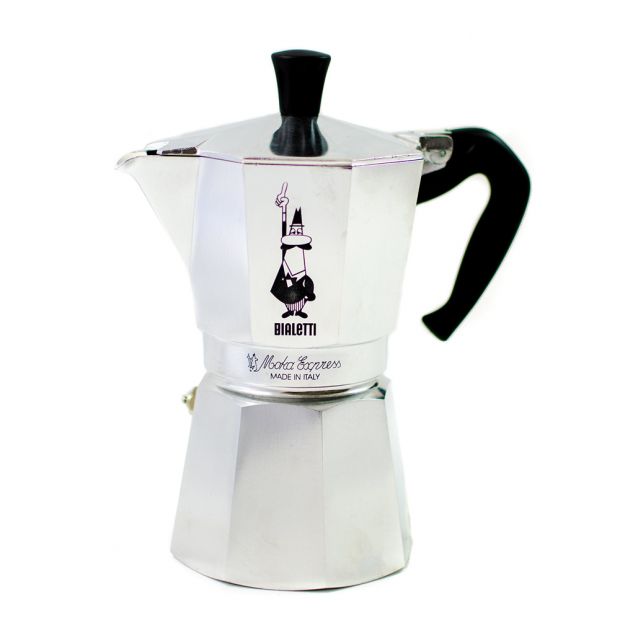
As Bodum is to cafetières, Bialetti is to stove-top espresso makers. The original Moka Express model was created in 1933 and millions have used it to make perfect coffee since. RRP £35 (six cup model), check price and buy on amazon.co.uk

Nick Harris-Fry is a journalist who has been covering health and fitness since 2015. Nick is an avid runner, covering 70-110km a week, which gives him ample opportunity to test a wide range of running shoes and running gear. He is also the chief tester for fitness trackers and running watches, treadmills and exercise bikes, and workout headphones.
